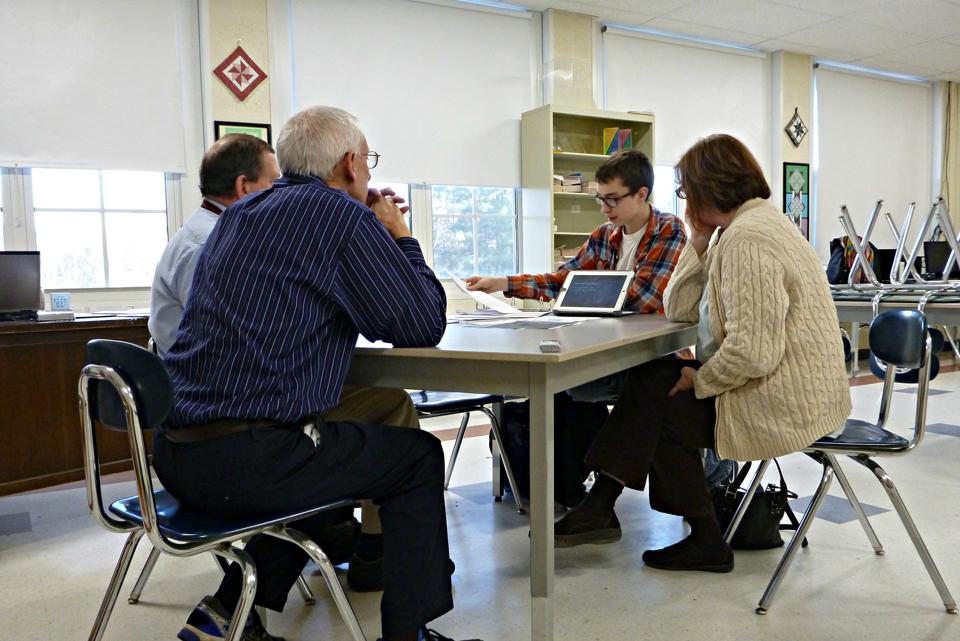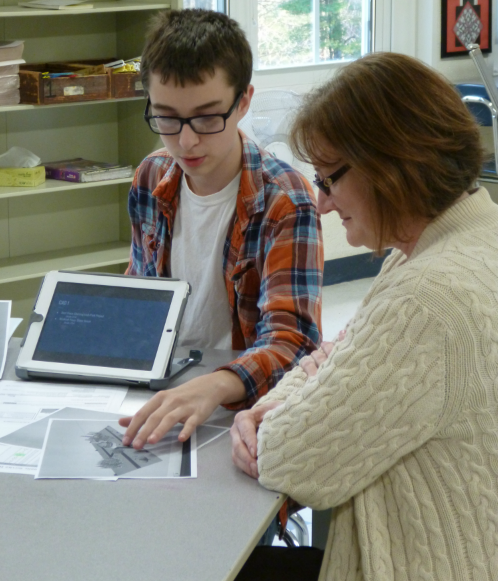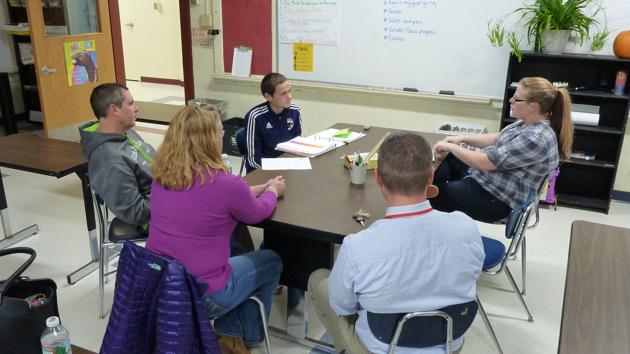
How a New Hampshire school gives its
students more responsibility—and freedom—to shape their academic lives
PITTSFIELD, N.H.—Pushing up the
cuffs of his plaid shirt and adjusting his glasses, the ninth-grader Colton
Gaudette looks across the small classroom conference table.
“Welcome to my student-led
conference,” he says.
“Thank you for inviting me,” answers
his mother, Terry Gaudette, sitting next to Colton’s adviser and biology
teacher.
This meeting, which happens twice a
year, has replaced the old format of parent-teacher conferences at Pittsfield
Middle High School, a rural New Hampshire campus that takes a “student-centered
learning” approach to schooling. With this model, students are
given more freedom to connect their individual interests to their academic
learning and future goals. Teachers are considered collaborators and coaches,
and students are expected to shoulder more responsibility for their school
lives—including organizing all the details of these twice-yearly conference
with parents and advisers.
Pittsfield began shifting to this
student-centered approach after being rated one of the state’s
lowest-performing high schools, and qualifying for a federal School Improvement
Grant in 2009. It’s also part of a coalition of 13
New England schools that share another $5 million federal
grant, and was awarded $2 million from the Nellie Mae Education Foundation in
2012, specifically to foster student-centered learning.
“Kids have to be honest with
themselves and I think that’s fantastic,” said Paul Strickhart, who teaches
math at Pittsfield and is Colton’s faculty adviser. “They have to own up to why
they’re not passing a class, or, if they’re doing well, they have to be able to
identify what’s contributing to that and how they can keep going.”
The student-led conferences are also
a way to teach skills you can’t learn from a textbook: organization, long-term
planning, confidence with public speaking, collaboration and self-reflection—even how to shake hands and make introductions in a more
formal setting. That aligns with a larger goal for Pittsfield’s students—to move beyond rote knowledge to develop the kind of
critical-thinking skills needed for “real world” success, said John Freeman,
the district’s superintendent. The unique conference format has helped to
kick-start family engagement, helping the combination middle-high school to
better serve its 260 students and the rest of the former mill town’s 4,500
residents.
Indeed, from New York to Washington State, student-led conferences have
been praised for breathing new life into an otherwise perfunctory process.
According to school officials and families at Pittsfield, before the new format
was adopted a few years ago, turnout for the traditional parent-teacher
conferences was dismal—less than 20 percent participated. Now, more than 90
percent of parents regularly show up.
Students are responsible for writing
a letter inviting their parents or guardians to attend, coordinating with their
faculty adviser to schedule the conference, and preparing a portfolio of their
academic work. The conferences typically last about 30 minutes, including time
for parents to ask questions and for the faculty adviser to give feedback on
the presentation. Students are expected to discuss their academic, social, and
emotional progress and outline their short- and long-term goals.

At the classroom table, Colton lays
out samples of his schoolwork—showing
some of his strongest work and several assignments with which he had less
success. In English class, Colton says he had an easier time crafting his
literary analysis ofLord of the Flies than the subsequent
assignment for The House on Mango Street. He’s working hard to keep
his grade up in geometry, and intends to earn at least a 3.5 (out of possible
4) for both semesters. His geopolitical-studies class is going well, as is
computer-assisted drafting—his blueprints for a set of shelves
turned out better than his first effort designing a stone bench.
Colton also shares the results of
several questionnaires the school uses to help him learn more about his
personality and learning style. The results: “I’m empathetic, artistic, and
kind of shy,” Colton says. His strengths include music, writing, and hands-on
learning. The personality assessments bolster the plans he has for the future:
He wants to study creative writing in college and potentially launch his own
comic-book company. So his biology teacher encourages Colton to look for more
opportunities to connect his artistic interests with his academic learning—he could have gone further with an in-class assignment
asking him to describe the life cycle of a cell, for example.
“I felt down when I got that
[assignment] back and you wrote that we could be more creative,” Colton says.
“I want to try that.”
At the conclusion of the conference,
Colton thanks the adults for participating, and says he is feeling good about
where things stand for him.
“That was very well done, very
thorough,” his math teacher tells him.
His mother is also impressed.
“You’ve been so nervous about this—I think you did an excellent job presenting,” she says. “And
you know how to better prepare yourself for some of this academic work.”
“How many of us appreciated, as a
student, being talked about in the third person as if we were invisible?”
At Pittsfield, students are expected
to begin preparing for the conferences about a month ahead of time, using a
checklist to mark off each of the requirements—including
confirming the meeting times with all of the adults, reviewing their
portfolios, and preparing answers to the self-reflection questions. Lauren
Martin, a Pittsfield senior, said even though it means more work for her, she
prefers the revised format to the traditional conference, which didn’t usually
include the students. Instead, she would have to wait at home for a replay—and then only get her parents’ perspective on the
discussion.
Now, as each semester progresses,
Lauren said she’s keeping an eye out for projects and papers she wants to add
to her portfolio. “It gives me more control of what I share,” Lauren said. “I
know more about my academics than the one teacher who’s my adviser, so it’s up
to me to decide what I’m going to include from each class.”
While not a new idea, the
student-led conference is an approach that’s “gaining speed and traction,” said
Monica Martinez, an education strategist and senior scholar for the William and
Flora Hewlett Foundation. (The Hewlett Foundation is among The
Hechinger Report’s many funders.) The co-author of a book of case
studies examining school approaches to “deeper learning,” Martinez
said the student-led conferences can be a powerful tool for improving students’
engagement with their learning process.
“How many of us appreciated, as a
student, being talked about in the third person as if we were invisible?” Martinez
asked. “When it’s just the teachers and parents participating in the conference
it can end up as ‘we’re going to dictate what you’re good at and what you’re
not good at.’ That’s taking away the power.”
 Emily
Richmond / The Hechinger Report
Emily
Richmond / The Hechinger Report
That being said, a student-led
conference by itself won’t mean much, Martinez added. “The school must be
really transferring ownership to the students and making it clear that kids
have plenty of opportunities to reflect on their work.”
Jenny Wellington, an English teacher
at Pittsfield, agrees. The schoolwide shift to student-centered learning is one
key reason that the conferences work, according to Wellington. In class,
students get a say in choosing their academic projects, which not only makes
them more excited about working on their assignments but also about presenting
them at the conferences once they’re completed. She added that parents can also
still getting in touch with teachers at other times to ask questions or to
request meetings.
Pittsfield’s teachers said the
conferences are also an opportunity to observe students’ interactions with
their families, and those moments can be an important window into understanding
their attitudes and classroom behavior. Conferences don’t always go smoothly.
Wellington said she’s observed meetings in which a student’s stated
post-high-school career plans vastly differed from what their families had in
mind. For example, one student was hoping to attend an out-of-state college,
while her parent expected her to stay local or perhaps prepare to work in the
family business.
“That can be heartbreaking,”
Wellington said. “You see the parent maybe trying to push the kid in a
direction that the kid doesn't want to go in, and as their teacher you didn't
know that dynamic was happening at all.”
In such instances, Wellington tries
to encourage the families to use the conference as an opportunity to talk
through their differences. Ideally, the result will be a plan of action that
incorporates the student’s goals while fostering parental support.
To be sure, those kinds of
negotiations work best when teachers know their students well. And Pittsfield’s
small size certainly helps. But Wellington, who taught middle school for six
years in New York City, said she could also see it working in a larger school
setting provided there is a reasonable student-teacher ratio.
“I get to shape my own life starting
here at this school.”
Pittsfield tries to accommodate
parents’ requests to schedule the student-led conferences early in the morning
before class or in the evenings after they finish work, Wellington said. That’s
a better use of her time, she said, than the standard procedure at her old
school in the Bronx, where classes would be canceled for a day and parents had
to show up during that time—or not.
“Usually the parents who did make it
to the conferences weren’t the ones you needed to see. It would be a quick
conversation with me saying, ‘Your kid is doing great, keep it up,’ and that
was it,” Wellington said. “Now the parents are hearing directly from the
students — it’s a completely different kind of conversation, and
it’s so much better.”
While the successes and benefits of
the student-led conferences are widely acknowledged, there is still room for
improvement. Parents of older students have been through the process enough
times that it’s becoming familiar and even rote, said Derek Hamilton,
Pittsfield’s dean of operations. More families seem to be having regular
conversations at home with their kids about their day-to-day academic progress—a very positive development, he added—but that means there isn’t as much new information to share
in the conferences.
To combat that fatigue factor,
Pittsfield is looking for ways to make the conferences more explicitly about
the student’s post-graduation plans and goals and to “raise the stakes” for
their presentations as they advance by grade—maybe by asking juniors and
seniors to present in front of a larger audience, including community members
from outside the school, rather than just sitting at a table with parents and
teachers.

In the meantime, it’s clear that the basic logistics of the
existing conferences are teaching the students important lessons, contends
Hamilton.
“You’d be surprised how many kids struggle to fill out an envelope
to invite their guests to a student-led conference,” Hamilton said. “People
laugh sometimes about the cliché of ‘21st-century skills’ but these are things
every one of these kids is going to need to know how to do in their adult
lives.”
Colby Wolfe, a freshman, has taken advanced math classes since the
seventh grade and said he hopes to follow his mother—an investment
banker—into a career in finance. During his most recent student-led
conference, his adviser told the family that the reports she’s gathered from
his other teachers are highly positive. Because Pittsfield allows students to
take advanced classes once they’ve mastered their required grade-level content,
Colby will have accumulated enough credits by the end of freshman year to be
ranked as a mid-year sophomore.
Part of the reason Colby’s doing so well academically, he said, is
that he gets to choose projects that most interest him and relate to his
post-high-school goals, for example one project where he looked at the
financial aspects of professional sports, incorporating academic work from
several different classes.
“I get to shape my own life starting here at this school,” Colby
said. “I have to say I think that’s pretty cool.”
While it was largely an upbeat conversation punctuated by moments
of genuine humor—his father joked that “this is the most I’ve ever heard
you talk at one time”—Colby didn’t gloss over the facts. He said he’s
finding some aspects of his English class challenging (his grade is the
equivalent of a solid B while he’s getting an A in math), including a recent
assignment that required him to connect a fiction reading to real-life
experiences. He was also disappointed not to have stronger marks in Spanish.
When his adviser mentioned that Colby could speak to the Spanish
teacher about his concerns, the high-school freshman respectfully rejected the
suggestion—at least for now.
“I think I can bring my grade up by doing better on the
assignments,” Colby said, looking around the table at his parents and adviser.
“I want to try that first.”
No comments:
Post a Comment